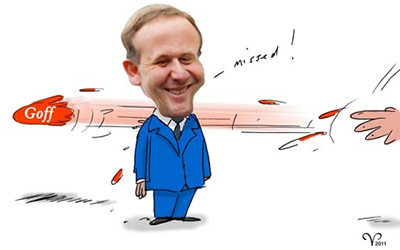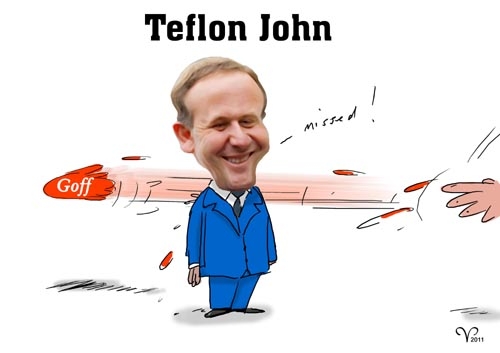Tactics and polls or preference voting


Missing the Message: Labour is set to continue to miss the mark as long as it continues to put party hacks up against a person perceived as a non-politician. Of the Davids in contention, only Shearer stands a chance of changing public perceptions of Labour as a cadre of self-serving career politicians—and Shane Jones as his running mate would greatly change Māori perceptions of the party. cartoon Majorlook Productions
It was uncannily similar to ancient Greece.
In Saturday’s tactical voting, where 54% could be said to have voted against John Banks, citizens were mimicking the first formal Greek use of the ballot, which was to ostracise a civic leader—his name having been scratched on a piece of broken pottery.
Tactical voting is a characteristic of the first-past-the-post method used to select electorate candidates, and it is greatly aided by pre-election opinion polling. In the case of the Epsom electorate, it was well understood, by Labour and Green party supporters in particular, that a vote for Paul Goldsmith was the best tactical option to deprive the National Party of a potential coalition support partner. The early results indicated that the tactic might work, but given that Epsom is a National stronghold, hardly surprising that it did not.
In contrast, tactical voting against Colin Craig and his newly formed Christian-leaning Conservative Party in Rodney was hampered by the lack of pre-election voter polling—but some left and green-leaning voters were sufficiently concerned to vote for National’s new man Mark Mitchell. As it transpired, Craig’s million-dollar campaign and the resultant 2.76% of the party vote cost National an outright majority and ability to govern alone. The Lord moves…
Pre-election opinion polling has been practiced for two hundred years, and its contribution to the bandwagon and underdog effects, and to strategic voting, is understood. Highlighted by Labour’s loss on Saturday, the bandwagon effect overwhelms the underdog effect.
Much of the need, and opportunity, for pre-election polls and tactical voting disappears when preference voting is made an integral part of an electoral system. In Rodney a Green-leaning voter, for example, might have ranked Teresa Moore (Green) 1, Christine Rose (Labour) 2, and Mark Mitchell (National) 3. In the event, Mark Mitchell won 52.6% of the vote, but had this been a marginal seat and his majority been other than absolute, a very different scenario might have played out. As the hypothetical Green supporter’s single transferable vote worked its magic, it would have first been transferred to Rose, who did twice as well as Moore, and then from Rose to Mitchell, who did four times as well as the Labour candidate.
In short, preference voting allows voters to express their honest preferences, without the need to know up-to-the-minute poll results, and safe in the knowledge that, as the results come in that evening, they won’t regret not taking the Machiavellian option of ranking Moore, Rose and Mitchell in the reverse order.
The use of preference voting should not stop with the electorate vote. Votes cast for parties that failed to be represented on Saturday would otherwise have helped to elect four list members. Again, it is simply a matter of allowing the voter to rank their preferences. Had preference voting been allowed on this election, the Green Party would have been relieved of the third party squeeze that makes the road to power such an agonisingly prolonged journey—39 years and counting, since the Greens forerunner, the Values Party, contested its first election.
Curbing the publication of pre-election opinion polls would do little to dissipate the bandwagon effect and much to curb freedom of expression. In addressing the ills of democracy, more information is always to be preferred to less, as is more democracy to less. Meantime, had mixed member proportional incorporated preference voting on 26 November 2011…
…green might already be the colour of the second highest polling party.
